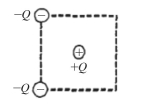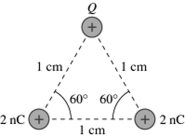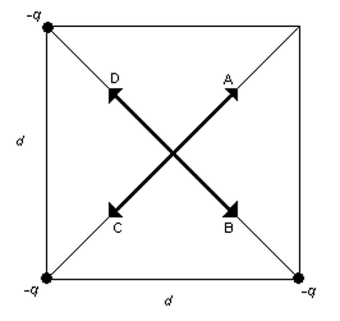A) -0.55 N
B) 0.55 N
C) 0.64 N
D) 0.41 N
E) -0.41 N
Correct Answer

verified
Correct Answer
verified
Multiple Choice
Two tiny particles carrying like charges of the same magnitude are  Apart.If the electric force on one of them is
Apart.If the electric force on one of them is  What is the magnitude of the charge on each of these particles? (k = 1/4πε0 = 9.0 × 109 N ∙ m2/C2)
What is the magnitude of the charge on each of these particles? (k = 1/4πε0 = 9.0 × 109 N ∙ m2/C2)
A) 2.4 × 10-2 C
B) 2.4 × 10-8 C
C) 4.5 × 104 C
D) 2.4 × 10-5 C
Correct Answer

verified
Correct Answer
verified
Multiple Choice
A +5.0-μC point charge is placed at the 0 cm mark of a meter stick and a -4.0-μC charge is placed at the 50 cm mark.What is the net electric field at the 30 cm mark? (k = 1/4πε0 = 8.99 × 109 N ∙ m2/C2)
A) 4.0 × 105 N/C
B) 5.0 × 105 N/C
C) 9.0 × 105 N/C
D) 1.4 × 106 N/C
Correct Answer

verified
Correct Answer
verified
Multiple Choice
One point charge +Q is placed at the center of a square,and a second point charge -Q is placed at the upper-left corner of the square.It is observed that an electrostatic force of magnitude 2.0 N acts on the positive charge at the center.Now a third charge -Q is placed at the lower-left corner of the square,as shown in the figure.What is the magnitude of the net force that acts on the center charge now? 
A) 0.0 N
B) 2.8 N
C) 4.0 N
D) 5.3 N
Correct Answer

verified
Correct Answer
verified
Multiple Choice
When 1.0-µC point charge is 15 m from a second point charge,the force each one experiences a force of 1.0 µN.What is the magnitude of the second charge? (k = 1/4πε0 = 9.0 × 109 N ∙ m2/C2)
A) 25 C
B) 1.0 C
C) 10 nC
D) 0.025 C
E) 25 nC
Correct Answer

verified
Correct Answer
verified
Multiple Choice
Two point charges,Q1 and Q2,are separated by a distance R.If the magnitudes of both charges are halved and their separation is also halved,what happens to the electrical force that each charge exerts on the other one?
A) It increases by a factor of 16.
B) It increases by a factor of 8.
C) It increases by a factor of 2.
D) It increases by a factor of 4.
E) It remains the same.
Correct Answer

verified
Correct Answer
verified
Multiple Choice
A plastic rod is charged up by rubbing a wool cloth,and brought to an initially neutral metallic sphere that is insulated from ground.It is allowed to touch the sphere for a few seconds,and then is separated from the sphere by a small distance.After the rod is separated,the rod
A) is repelled by the sphere.
B) is attracted to the sphere.
C) feels no force due to the sphere.
Correct Answer

verified
Correct Answer
verified
Multiple Choice
As shown in the figure,three charges are at the vertices of an equilateral triangle.The charge Q is 6.7 nC,and all the other quantities are accurate to two significant figures.What is the magnitude of the net electric force on the charge Q due to the other two charges? (k = 1/4πε0 = 9.0 × 109 N ∙ m2/C2) 
A) 2.1 × 10-3 N
B) 1.2 × 10-3 N
C) 1.0 × 10-3 N
D) 1.4 × 10-3 N
Correct Answer

verified
Correct Answer
verified
Multiple Choice
Two uncharged metal spheres,#1 and #2,are mounted on insulating support rods.A third metal sphere,carrying a positive charge,is then placed near #2.Now a copper wire is momentarily connected between #1 and #2 and then removed.Finally,sphere #3 is removed.In this final state
A) spheres #1 and #2 are still uncharged.
B) sphere #1 carries positive charge and #2 carries negative charge.
C) sphere #1 carries negative charge and #2 carries positive charge.
D) spheres #1 and #2 both carry positive charge.
E) spheres #1 and #2 both carry negative charge.
Correct Answer

verified
Correct Answer
verified
Multiple Choice
Three point charges are located on the x-axis at the following positions: Q1 = +2.00 μC is at x = 1.00 m,Q2 = +3.00 μC is at x = 0.00,and Q3 = -5.00 μC is at x = -1.00 m.What is the magnitude of the electric force on Q2? (k = 1/4πε0 = 8.99 × 109 N ∙ m2/C2)
A) 0.0540 N
B) 0.135 N
C) 0.158 N
D) 0.0810 N
E) 0.189 N
Correct Answer

verified
Correct Answer
verified
Multiple Choice
Two equally charged tiny spheres of mass 1.0 g are placed 2.0 cm apart.When released,they begin to accelerate away from each other at  What is the magnitude of the charge on each sphere,assuming only that the electric force is present? (k = 1/4πε0 = 9.0 × 109 N ∙ m2/C2)
What is the magnitude of the charge on each sphere,assuming only that the electric force is present? (k = 1/4πε0 = 9.0 × 109 N ∙ m2/C2)
A) 140 nC
B) 120 nC
C) 95 nC
D) 75 nC
Correct Answer

verified
Correct Answer
verified
Multiple Choice
Three identical 3.0-µC charges are placed at the vertices of an equilateral triangle that measures 30 cm on a side.What is the magnitude of the electrostatic force on any one of the charges? (k = 1/4πε0 = 9.0 × 109 N ∙ m2/C2)
A) 1.6 N
B) 1.8 N
C) 2.0 N
D) 2.2 N
E) 2.4 N
Correct Answer

verified
Correct Answer
verified
True/False
Electrically neutral objects cannot exert an electrical force on each other,but they can exert a gravitational force on each other.
Correct Answer

verified
Correct Answer
verified
Multiple Choice
If two objects are electrically attracted to each other,
A) both objects must be negatively charged.
B) both objects must be positively charged.
C) one object must be negatively charged and the other object must be positively charged.
D) the objects could be electrically neutral.
E) None of the above statements are absolutely true.
Correct Answer

verified
Correct Answer
verified
Multiple Choice
A particle with a charge of +4.0 μC has a mass of 5.0 g.What magnitude electric field directed upward will exactly balance the weight of the particle?
A) 4.1 × 104 N/C
B) 8.2 × 104 N/C
C) 4.4 × 104 N/C
D) 1.2 × 104 N/C
E) 5.1 × 104 N/C
Correct Answer

verified
Correct Answer
verified
Multiple Choice
A small charged plastic ball is vertically above another charged small ball in a frictionless test tube as shown in the figure.The balls are in equilibrium a distance d apart.If the charge on each ball is doubled,the equilibrium distance between the balls in the test tube would become 
A) ![]() d.
d.
B) 2d.
C) 4d.
D) 8d.
E) d/4.
Correct Answer

verified
Correct Answer
verified
Multiple Choice
Three equal negative point charges -q are placed at three of the corners of a square of side d as shown in the figure.Which one of the arrows shown represents the direction of the net electric field at the center of the square? 
A) A
B) B
C) C
D) D
Correct Answer

verified
Correct Answer
verified
Multiple Choice
The zirconium nucleus contains 40 protons,and an electron is 1.0 nm from the nucleus.What is the electric force on the electron due to the nucleus? ( e = 1.60 × 10-19 C,k = 1/4πε0 = 9.0 × 109 N ∙ m2/C2)
A) 2.9 nN
B) 1000 C
C) 3.7 nN
D) 6.8 nN
E) 9.2 nN
Correct Answer

verified
Correct Answer
verified
Multiple Choice
Two tiny particles having charges +20.0 μC and -8.00 μC are separated by a distance of 20.0 cm.What are the magnitude and direction of electric field midway between these two charges? (k = 1/4πε0 = 9.0 × 109 N ∙ m2/C2)
A) 25.2 × ![]() N/C directed towards the negative charge
N/C directed towards the negative charge
B) 25.2 × ![]() N/C directed towards the positive charge
N/C directed towards the positive charge
C) 25.2 × ![]() N/C directed towards the negative charge
N/C directed towards the negative charge
D) 25.2 × ![]() N/C directed towards the positive charge
N/C directed towards the positive charge
E) 25.2 × ![]() N/C directed towards the negative charge
N/C directed towards the negative charge
Correct Answer

verified
Correct Answer
verified
Multiple Choice
Two tiny beads are 25 cm apart with no other charges or fields present.Bead A carries 10 µC of charge and bead B carries 1 µC.Which one of the following statements is true about the magnitudes of the electric forces on these beads?
A) The force on A is 10 times the force on B.
B) The force on B is 10 times the force on A.
C) The force on A is exactly equal to the force on B.
D) The force on A is 100 times the force on B.
E) The force on B is 100 times the force on A.
Correct Answer

verified
Correct Answer
verified
Showing 21 - 40 of 75
Related Exams